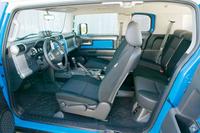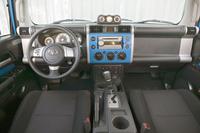Clear and Vibrant - 2007 FJ Cruiser Exemplifies Toyota's Design Philosophy
Torrance, CA December 22, 2005; A home run or a dream, come true? To its designers, the 2007 Toyota FJ Cruiser is both those things, and more. To Kevin Hunter, vice president of Calty Design Research, the California-based Toyota design studio in which the FJ Cruiser concept vehicle was born, it's a home run. For Jin Kim, who designed the vehicle's exterior, it's a dream come true. But perhaps most importantly, it's a steel-and-glass statement of Toyota's commitment to great design.
With the FJ Cruiser, Toyota seemingly accomplished the impossible: It captured and distilled the essence of an iconic, 40-year-old vehicle, the classic Toyota Land Cruiser FJ40. Then it poured that essence into an all-new design without making that new design a retrospective restatement of the original. It reprised several of the FJ40's most compelling stylistic themes, but did so in ways that are completely contemporary and fresh. And that was exactly what Hunter, Kim and interior designer Bill Chergosky all had in mind.
The challenge, first posed in early 2002 by executives from Toyota Motor Sales, was simple: Design a show vehicle that targeted young buyers and that offered a rugged, functional look recalling the classic Land Cruiser and its heritage.
Kim and two other designers were asked by Hunter to research some ideas. Whoever came up with the most intriguing idea would be assigned the final concept-vehicle design project.
Kim's research pointed him toward the FJ40. "The more I got into it, the clearer it was to me that this was what Toyota was looking for," said Kim. "The design is charming. It has nice volume and a good stance. It's kind of boxy and very rugged. I learned that there are still a lot of people who are FJ40 fanatics, so I decided to go in the FJ40 direction."
Yet the need was for something new, not something old. Said Kim, "I wanted to make sure I didn't take the design in a retro direction. I wanted to do something very new and modern, but with a sense of the FJ40 to show the heritage of it, not just a literal FJ40 re-do."
Kim, 28, a graduate of the Art Center College of Design in Pasadena, California, chose as his starting point the vehicle's overall image. The look he was after, he said, was what he called "industrial modern." He explained, "To me, that means tool-like, a combination of ruggedness and functionality, with an honest look and modern surfaces."
Kim's initial sketches explored a number of variations on Land Cruiser themes. As he progressed, he got a clearer idea of what the final vehicle could look like – a process that included thinking about the elements that made the FJ40 a memorable design.
He settled on the FJ40's two round headlights set on either side of a mesh grille, and mounted within a grille surround element: its upright windshield, its white top and its wrap-around rear-corner glass.
"I tried to interpret those in a modern way that's not literal but has the same feeling," Kim explained, and added, "I think that just looking at the grille/headlight treatment and the white roof makes an immediate connection to FJ40, even though the final FJ Cruiser design uses totally different proportions and construction."
Kim added, "The proportion I wanted to express was rugged, leaning forward in an aggressive gesture. I was able to achieve that by using a wedged roofline and a short overhang. Combining those two gave it a forward-leaning posture. The surfaces are flat. It has a nice tension and a nice volume. It's not organic, but at the same time it feels very muscular."
Hunter, a graduate of the College for Creative Studies in Detroit, liked what he saw. "We knew this concept was going to be some kind of Land Cruiser vehicle, but we weren't sure which one," said Hunter. "The sketches that Jin presented communicated, in a very modern way, the essence of the FJ40. We could feel it immediately when we saw the sketches. Sketches from the other designers were nice designs, but they didn't connect to the past in a way we thought was interesting. We felt that Jin's design was the best of both worlds."
Kim's sketches may indeed have been the best of past and present, but a design sketch is a universe away from a real-world design that can be translated into a full-size model of the proposed concept vehicle. So Kim's initial sketch underwent a process of refinement.
"Once we decided on a theme, there were a series of management reviews to improve and develop the design," said Hunter. "We did a lot of proportional tuning. We looked at the cab and body ratios and the windshield angles. We experimented with a lot of different things. In the end, it was really a compelling design with a lot of charm and character. It communicated an honest, purposeful function that was easy to understand in an emotional way. I think we had a clear philosophy from the beginning about what we wanted it to be. We stuck to that. I don't feel we compromised anything along the way."
While Kim was working on the exterior design, Bill Chergosky, 35, also a graduate of the College for Creative Studies in Detroit, was tasked with coming up with an interior for the project. Like Kim, he also was thinking in terms of tools.
"A hammer is a great metaphor for the way the interior of the FJ40 is constructed," said Chergosky. "A hammer looks the way it does because it has to drive a nail. When I sat down to design this interior, I looked at the FJ40's interior. It's a product of manufacturing. One of the style elements is purity - there is no styling. It's composed of a big metal tub, some pieces of Masonite wrapped in vinyl and an instrument panel jammed right up against the firewall. I wanted to convey a similar charm. That's the design intent filtered through the engineering process. It is what it is. It's like a tool."
Chergosky's intent was to work from that philosophy, but with modern design tools and manufacturering processes. That meant using a computer instead of a pencil and sketchpad, and it also meant altering his workflow.
"Usually, designers create a shape and then design a process that will produce that shape," said Chergosky. "But this time, I wanted the components, the architecture, to be somewhat process-driven. I wanted the components to be extrusions, castings and CNC-milled pieces. Setting out with a production and assembly process probably is how they did the original FJ40. They created a style, something magical, out of that."
The process of creating something magical this time around was helped by Toyota's recently enunciated design philosophy. That philosophy is stated by the phrase, "vibrant clarity."
Hunter explained, "We're all trying to communicate this. By vibrancy, we mean energetic and active. Clarity is something that is honestly communicated. It's easy to understand why it's here, what it's meant to do. That's what we're trying to capture."
With this design philosophy as a guide, the final tuning of the concept's design was completed and Kim began building a full-size model.
"When it was all done and painted, we presented it to the executives at Toyota Motor Sales, said Hunter. "It was stunning. We all felt that this was going to be a true winner. Sometimes you're not fully satisfied and you think, ‘It's too bad we didn't do this or that.' But this was one of those projects where you just felt this was a great design."
Hunter, Kim and Chergosky were sure that they were on the right design path, but none of them was prepared for the reception the FJ Cruiser concept vehicle got at the 2003 North American International Automobile Show in Detroit.
The FJ Cruiser's unveiling took place toward the end of the show's media days. When the coverings were lifted from the glowing blue-and-white FJ Cruiser, it was clear that Hunter and his team had a hit on their hands.
Hunter said of the unveiling, "It was a home run - not only according to the media, from whom we heard a lot of positive things, but also according to our design colleagues, who came up and complimented us. The FJ Cruiser was understandable. You didn't have to explain that vehicle to anyone. Everyone knew instantly what it was. It was amazing to see people's response to it. The fact that it was connected to the FJ40 completed it as a home-run statement."
Kim recalls, "When I saw what a success it was, I was blown away. The response it got was very satisfying. A lot of times after you spend time designing something, you've been looking at it so long you don't know how it will be received by those who've not seen it. At a certain stage you start to wonder about the design. So it was very satisfying to see that other people had positive reactions. It was a dream come true."
Concept cars are flights of artistic fantasy, vehicles in which ideas count more than practicality does, in which impact and artistic expression trump production concerns. So it is perhaps understandable that the FJ Cruiser's designers expected that their interior and exterior designs, so carefully plotted, might be victimized by the exigencies and realities of production, and by the process of engineering a real-world vehicle from something intended only for the world of show. Yet the FJ Cruiser was put into production in a form that is almost completely unchanged from that of the concept vehicle. There is a solid reason for that, according to Hunter. He said, "I think there was a strong commitment from the chief engineer to this concept vehicle's design. The best designs come about when design and engineering work together. That's what we're trying to do at Toyota. We're trying to expand our design vocabulary, to do more emotional design."
"The engineers really outdid themselves," said Kim. "Often, because of issues related to cost, packaging or visibility, production vehicles lose some of the concept vehicle's design touches. There were things I thought would go away with this one, but the engineers managed to keep most of the design elements. I thought, for instance, that the first things they would get rid of were the indicator lamps in the side-view mirrors. But they kept even those."
At the end of the day, the FJ Cruiser is much more than merely a successful design exercise that made it into production. It also is a clear statement of how Toyota's design philosophy can be turned into hard metal.
Explained Hunter, "Vibrant clarity helps us to solidify the way we are thinking about design. Translating it visually is often difficult, so it helps to have an example to use as a benchmark. The FJ Cruiser is just such a benchmark."
Hunter added, "What is significant about the FJ Cruiser project is that working together, we created a concept car that was widely recognized for its excellence. It then became a production car. This marks the first time at Calty we've taken a concept right to production. So I think that's a testament to a strong commitment to design, to understanding its importance, and to people working together."






